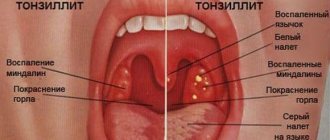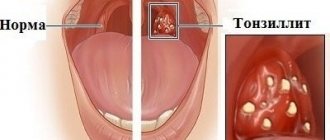Increased body temperature, painful sensations in the throat, weakness, headache - people usually attribute these symptoms in the spring-winter period to a common cold. However, often such signs indicate the development of a dangerous infectious disease, which doctors call purulent tonsillitis. The disease is manifested by severe inflammation of the tonsils (glands), located in the nasopharynx. The infection primarily affects the parenchyma and lymphoid tissue lining the tonsils. The disease is dangerous due to severe complications that develop when symptoms are ignored and there is no proper treatment.
If you suspect that you have a sore throat and need to consult a doctor, call +7 (499) 653-58-25 - we will definitely help you. Reception is carried out both in the clinic and with a visit to the patient’s home. To register online, fill out the form on the website.
Causes
Inflammation of the palatine tonsils is provoked by infections transmitted by airborne droplets. Less commonly, infection occurs through contact and household contact (through shared dishes, towels, bed linen). The most common causative agent of purulent sore throat is hemolytic streptococcus. However, if a person’s immune system works normally, bacteria of this group die immediately after entering the body. The development of pathology is facilitated by weakened immunity and provoking factors.
Indirect causes of purulent sore throat include:
- severe hypothermia;
- chronic diseases of the upper respiratory tract;
- oral infections;
- alcoholism and smoking history;
- stress, overwork, strong emotional tension;
- living in areas with difficult environmental conditions;
- deficiency of vitamins and nutrients;
- mechanical damage to the tonsils (trauma, surgery).
The disease is diagnosed with equal frequency in adults and children.
Causes of development of chronic tonsillitis
The development of chronic tonsillitis is possible according to 2 scenarios:
- as a result of tonsillitis (acute tonsillitis), which was incorrectly treated or the treatment was not completed;
- as a result of decreased immune defense and constant exposure to aggressive factors (this is a non-anginal option).
The following are aggressive stimuli:
- inhalation of tobacco smoke;
- poor nutrition;
- alcohol abuse;
- carious teeth;
- inflammatory processes in the paranasal sinuses (sinusitis, sinusitis, etc.);
- impaired nasal breathing that occurs when the nasal septum is deviated, polyps or hypertrophy of the inferior turbinates. Under such conditions, the oral mucosa dries out and the formation of immunoglobulin A is disrupted, which reduces the immune defense of the ENT organs.
However, exposure to the described factors alone is not enough for the development of chronic tonsillitis. Currently, it is considered the result of infection with pathogenic bacteria against the background of allergization (altered immune reactivity). Local changes in the lymphoid tissue after previous tonsillitis, as well as the factor of heredity, which manifests itself only under certain conditions of the internal and external environment, also have a role in this process.
Infection. The most common causes are streptococci and staphylococci. In this case, the maximum danger is posed by pyogenic streptococcus, which is called beta-hemolytic (belongs to group A). The risks associated with this pathogen are the likelihood of developing autoimmune diseases, i.e. when your own immune cells damage other cells in your body. This happens with glomerulonephritis, rheumatism, polyarthritis and other similar diseases.
Altered reactivity of the body (its allergization), which is characterized by excessive production of class E immunoglobulins. Under such conditions, the re-entry of antigens (for example, foreign bacterial proteins) triggers an allergic reaction that constantly maintains inflammation. This corresponds to the exacerbation phase of the pathological process.
It has been proven that the likelihood of chronic tonsillitis in people whose first- or second-degree relatives suffered from this disease is much higher than in other people. This is due to the peculiarities of the anatomy of the tonsillar crypts and immune status (tendency to an allergic response).
Incubation period
The period from the moment the pathogen enters the body until the appearance of the first characteristic symptoms can range from 2 to 6 days. During the first few days, the sick person is still unaware of his condition, becoming a source of infection for others. During the incubation period, the infection is actively transmitted by airborne droplets (through coughing, sneezing, kissing, talking). The onset of the disease is manifested by a feeling of chills, increased body temperature, weakness and headache. The sooner the patient sees a doctor, the easier the treatment is.
Causes
Tonsillitis is an infectious disease. It can be caused by various types of viruses:
- adenovirus, enterovirus, influenza and parainfluenza viruses;
- Epstein-Barr virus, cytomegalovirus infection;
- pathogens of measles, herpes simplex and others.
Bacterial tonsillitis is most often caused by streptococci. It can also be caused by staphylococci, gonococci, corynebacterium diphtheria, anaerobic flora, and spirochetes. Candida sore throat sometimes occurs in young children.
The development of the disease also involves factors that reduce the overall resistance of the body - hypothermia, malnutrition, prolonged emotional stress and others.
Treatment for tonsillitis depends on its causes. To determine the causative agent, timely consultation with a doctor is necessary.
Symptoms of purulent sore throat
In most patients, the first signs of purulent tonsillitis appear 2-3 days after the pathogen enters the body. When the patient's immunity is weakened, the clinical picture is most pronounced. In adult patients, the following symptoms are observed:
- the appearance of noticeable white or yellowish spots of pus on the tonsils;
- high body temperature (in the range of 39-40 ° C);
- intense pain in the throat that increases during swallowing;
- significant enlargement of the lymph nodes located under the lower jaw;
- easily removable whitish coating on the tongue;
- severe headaches;
- feeling weak and overwhelmed;
- loss of appetite;
- aching joints.
In adults, with timely treatment, the acute stage of the disease rarely lasts longer than a week. If the patient does not seek help from specialists, there is a risk of complications.
Signs of tonsillitis
The most reliable local signs of chronic tonsillitis are:
- Hyperemia and roller-like thickening of the edges of the palatine arches.
- Cicatricial adhesions between the tonsils and palatine arches.
- Loose or scarred and hardened tonsils.
- Caseous-purulent plugs or liquid pus in the lacunae of the tonsils.
- Regional lymphadenitis is an enlargement of the cervical lymph nodes.
The diagnosis is made in the presence of two or more of the above local signs of tonsillitis. In the compensated form, there are only local signs of chronic inflammation of the tonsils, the barrier function of which and the reactivity of the body are still such that they balance and even out the state of local inflammation, i.e. compensate for it, so a pronounced general reaction of the body does not occur.
In case of decompensation, there are not only local signs of chronic inflammation, but also tonsillitis, paratonsillitis, paratonsillar abscesses, diseases of distant organs and systems (cardiovascular, genitourinary, etc.)
Any form of chronic tonsillitis can cause allergization and infection of the entire body. Bacteria and viruses located in the lacunae under appropriate conditions (cooling, decreased body resistance, and other reasons) cause local exacerbations in the form of sore throats and even peritonsillar abscesses.
Rice. 1. Chronic follicular tonsillitis. Rice. 2. Chronic lacunar tonsillitis. Rice. 3. Chronic tonsillitis (Preobrazhensky sign). Rice. 4. Chronic tonsillitis (Gise’s sign)
Stages of disease development
The disease progresses rapidly. This is especially true in children and adults with a weakened immune response. Symptoms depend on the current state of the body, age, concomitant diseases and the stage of infectious tissue damage.
Signs of the development of the disease at different stages from the moment of infection:
- 2-3 days.
This stage is characterized by the maximum severity of the symptomatic picture. The patient's tonsils increase significantly in size and white or yellowish ulcers appear on their surface. The inflammatory process covers the entire surface of the tonsils. The patient notes deterioration in health, weakness, loss of appetite and signs of fever, including an increase in body temperature to 39-40 ° C. The patient also experiences excruciating pain in the throat, which gets worse when swallowing. - Day 4
The ulcers that form on the tonsils begin to spontaneously open, releasing the contents (pus). In their place, lacunae are formed - characteristic depressions. If at this stage the patient follows the doctor’s recommendations, the lacunae quickly close. - 5-6 day
. At this stage, patients feel a noticeable improvement in their condition - body temperature normalizes, headaches go away, strength and appetite are restored. - 7-10 day
. The last pathological sign – sore throat – recedes. The size of the lymph nodes located under the lower jaw also decreases. The patient ceases to feel pain and discomfort in this area.
Competent and timely therapy allows you to avoid serious complications.
Classification of tonsillitis
The disease can be acute or chronic. In the first case, signs of infection disappear within 7 to 10 days. In a chronic course, pathogens remain in the tissues of the tonsils, causing periodic exacerbations. Treatment of chronic tonsillitis is a complex task that only experienced otolaryngologists can handle.
Chronic tonsillitis has 2 forms - simple and toxic-allergic. In the latter case, there are 2 degrees of severity of pathological changes.
The simple form is characterized by only local symptoms. With the toxic-allergic variant, the following pathological processes occur:
- microbial toxins that enter the blood cause sensitization (altered reactivity) of the body;
- they act directly on the tissues of internal organs;
- toxins also lead to the development of allergic and autoimmune reactions.
To treat tonsillitis in this case, a complex effect on the entire body is necessary.
Forms of the disease
The form of purulent tonsillitis depends on many associated factors and conditions. The most common three forms of development are follicular, lacunar and ulcerative-membranous (necrotic). Each type is characterized by characteristics of the course, specific lesions of the tonsil tissue and varying duration.
Follicular
Follicular tonsillitis is manifested by pinpoint purulent lesions of the parenchyma of lymphoid tissue and follicles of the tonsils. The disease in 85% of cases is caused by group A streptococci. The remaining cases of infection are associated with staphylococcal infection, Haemophilus influenzae, pneumococcus, and adenovirus. This form of pathology is accompanied by a rapid increase in the symptom complex, severe hyperthermia, sweating, loss of sleep and appetite. Intense pain in the throat can radiate to the ear.
Lacunarnaya
This type of disease causes severe inflammatory damage to the tissues of the peripharyngeal ring. The opening of abscesses is accompanied by the formation of specific perforations on the surface of the tonsils - lacunae. The acute phase of the disease is manifested by an increase in the size of the tonsils, up to difficulty breathing. Along with other symptoms, a characteristic sign of the lacunar type of pathology is bad breath. Sometimes doctors note a noticeable change in voice and diction problems. Inadequate therapy can lead to the development of a paratonsillar or retropharyngeal abscess.
Necrotic
Necrotizing ulcerative tonsillitis is rare (about 5-6% of cases). The main cause of the development of this type of disease is fusospirochetous infection. The rapid development of the infectious-inflammatory process causes the formation of histological changes in the tissues of the palatine tonsils. Violations of vascular permeability, associated with the active production of histamine and cytokines, lead to hypertrophy and sometimes tissue necrosis. The first sign of the disease is the feeling of a “lump in the throat.” Later, a sharp, unpleasant putrid odor appears from the mouth and salivation increases.
Chronic form of tonsillitis
Chronic tonsillitis is characterized by repeated recurrence of tonsillitis. A long-lasting focus of infection forms in the palatine tonsils. This leads to a deterioration in the general condition:
- the patient experiences a constant or periodic increase in body temperature;
- the patient complains of fatigue, decreased mental and physical performance, sweating;
- Headaches, sleep and appetite disturbances are noted.
In the simple form of the disease, there is redness, enlargement of the tonsils and palatine arches, their fusion, and enlargement of the lymph nodes.
The toxic-allergic form is accompanied by damage to internal organs. In grade I, changes in the general condition, heart, joints, enlarged lymph nodes, and laboratory abnormalities are not constant. II degree of severity is accompanied by the following disorders:
- pain in the heart area, rapid heartbeat, heart rhythm disturbances, changes in the ECG;
- joint pain, which occurs not only during an exacerbation, but also during remission;
- prolonged increase in body temperature to subfebrile levels;
- changes in the functioning of the liver, kidneys and other organs, manifested by corresponding symptoms and changes in laboratory data.
Chronic tonsillitis is part of the pathogenesis of many other diseases - rheumatism, polyarthritis, glomerulonephritis, sepsis, pathology of connective tissue, endocrine, nervous, and digestive systems.
Diagnosis and treatment
To make a diagnosis and determine treatment approaches, you need to consult an otolaryngologist. Diagnostics is carried out according to the following algorithm:
- collection of medical history and complaints;
- examination of the pharynx using special lighting (pharyngoscopy);
- general and biochemical blood test;
- bacteriological examination of a smear with the preparation of an antibiogram.
How to treat a purulent sore throat is determined by an ENT specialist. In severe cases, hospitalization is required. General medical recommendations include bed rest, drinking plenty of fluids, taking vitamins and restorative medications.
Specific treatment of the disease is a complex of procedures and medications:
- Drug treatment of the oral cavity.
Complex therapy necessarily includes gargling with antiseptic solutions. For this purpose, solutions of furatsilin, manganese, hydrogen peroxide, sea salt, and natural herbal decoctions (chamomile, calendula) are used. This procedure is aimed at removing pathogenic microorganisms from the throat and mouth. - Taking systemic antibacterial drugs.
A full course of antibiotic therapy allows you to get rid of pathogenic flora. Antibiotics and their dosages can only be determined and prescribed by a doctor. The most commonly used drugs are from the groups of penicillins, macrolides and cephalosporins. - Symptomatic therapy.
To alleviate the patient’s condition during the acute stage, the specialist prescribes symptomatic treatment in the form of antipyretics, antihistamines and anti-inflammatory drugs. Sometimes it is recommended to undergo physiotherapeutic procedures during the recovery period.
Correctly selected treatment helps to avoid serious consequences and ensures healing of the affected tissue areas without visible defects.
Diagnostics
Diagnosis of chronic tonsillitis occurs on the basis of complaints, examination of the patient, and questioning of the patient. Objective signs, manifestations of chronic tonsillitis, and the general condition of the tonsils are important; the doctor determines the stages of the process and the form.
The following diagnostic procedures are also carried out:
- throat swab for flora;
- general blood and urine tests;
- blood test for antibodies to streptococcus.
This helps determine treatments for chronic tonsillitis.
Purulent sore throat in children
If the disease develops in a child, in addition to the main symptoms, digestive disorders often appear - diarrhea, nausea, vomiting. Children may complain of abdominal pain caused by intestinal spasms. The follicular type of pathology is especially difficult for children aged 5-10 years, causing inflammation of the meninges. Young patients often experience fainting, dry cough and complaints of a feeling of a foreign object in the throat.
If parents ignore the symptoms, the pathology becomes chronic. Pediatricians call this condition chronic tonsillitis, exacerbations of which occur 2-3 times a year.
Treatment methods in adults
In most cases, they resort to conservative treatment of chronic tonsillitis. Source: Modern methods of treating chronic tonsillitis. Ryazantsev S.V., Eremina N.V., Shcherban K.Yu. Medical Council, 2022. p. 68-72:
- therapy for inflammation in the head and oral cavity;
- procedures that increase immunity (hardening, taking vitamins, physical education, etc.);
- hyposensitizing drugs (to suppress allergic reactions);
- immunomodulators (normalize the immune system);
- means of reflex action (acupuncture, manual therapy);
- washing the tonsils with antiseptics;
- administration of drugs to the tonsils.
The treatment plan is complemented by physical therapy for chronic tonsillitis.
A radical method of treating chronic tonsillitis is surgical removal of the tonsils (tonsillectomy). The operation is performed in cases where inflammation occurs more than five times a year and does not respond to complex conservative treatment of chronic tonsillitis. Source: Choosing an antibiotic for exacerbation of tonsillitis. Karpishchenko S.A., Kolesnikova O.M. Medical Council, 2015. p. 40-43.
Complications and consequences
The advanced form of the disease leads to inflammatory damage to other organs, including the heart, kidneys, and joints. The most dangerous complications include:
- mediastinitis
– inflammation of the mediastinal tissue; - chronic bronchitis
- inflammatory damage to the bronchi; - sepsis –
spread of infection through the bloodstream; - arthritis -
inflammation of the joints; - glomerulonephritis is
a dangerous kidney disease; - purulent meningitis -
damage to the meninges; - peripharyngeal abscesses
- suppuration of the lymph nodes and tissue of the peripharyngeal space.
Timely access to a medical facility allows you to avoid negative health consequences.
Complications of tonsillitis
Tonsillitis, both acute and chronic, can cause local and general complications.
The first group includes damage to the tissues of the pharynx: paratonsillar abscess, parapharyngitis, laryngitis. Local complications also include acute otitis media and cervical lymphadenitis.
Common complications associated with damage to internal organs:
- diseases of the joints and connective tissue: rheumatism, rheumatoid arthritis, infectious polyarthritis, systemic lupus erythematosus;
- damage to the heart and mediastinum: myocarditis with the development of dilated cardiomyopathy and heart failure, mediastinitis;
- inflammation of the lungs, kidneys, appendix, sepsis and others.
To avoid the development of such complications, if there are symptoms of tonsillitis, it is necessary to carry out its full treatment.
Prevention
By paying attention to preventive measures, you can reduce the risk of developing the disease. Effective prevention includes:
- avoiding hypothermia (wearing warm clothes, monitoring microclimatic indicators in the room);
- regular preventative visits to the dentist to identify the early stages of caries and stomatitis;
- giving up bad habits (smoking, drinking alcohol);
- moderate physical activity, regular walks in the fresh air;
- normalization of diet, sleep and wakefulness;
- compliance with hygiene standards and requirements, maintaining cleanliness in the home and workplace;
- limiting contacts with unfamiliar people during periods of unfavorable epidemiological conditions.
Strengthening the immune system based on leading a healthy lifestyle helps to avoid infection and make it easier to endure purulent sore throat.
If you have a sore throat, call us and we will definitely help you!
A-STREPTOCOCCAL TONSILLITIS: clinical significance, issues of antibacterial therapy
What is meant by acute tonsillitis? Why is antibacterial therapy necessary for GABHS tonsillitis? Which antibacterial agents to choose?
Acute tonsillitis (tonsillitis)1 is a disease that is characterized by acute inflammation of one or more lymphoid formations of the pharyngeal ring (usually the tonsils) and is one of the widespread infections of the upper respiratory tract.
The most significant bacterial causative agent of acute tonsillitis is group A β-hemolytic streptococcus (Streptococcus pyogenes, GABHS). Less commonly, acute tonsillitis is caused by viruses, streptococci of groups C and G, Arcanobacterium haemolyticum, Neisseria gonorrhoeae, Corynebacterium diphtheria (diphtheria), anaerobes and spirochetes (Simanovsky-Plaut-Vincent angina), extremely rarely - mycoplasma and chlamydia.
GABHS is transmitted by airborne droplets. Sources of infection are sick and less often asymptomatic carriers. The likelihood of infection increases with a high degree of contamination and close contact with the patient. Outbreaks of acute GABHS tonsillitis most often occur in organized groups (in preschool institutions, schools, military units, etc.). Mostly children aged 5-15 years are affected, as well as people of young working age. The highest incidence is observed in the winter-spring period.
The high incidence of the disease, the contagiousness of the infection, large labor losses entailing economic damage, the possibility of developing serious complications - all this indicates that the problem of GABHS tonsillitis is still quite acute in both scientific and practical aspects.
Clinical picture. The incubation period for acute GABHS tonsillitis ranges from several hours to 2-4 days. This disease is characterized by an acute onset with an increase in temperature to 37.5–39 ° C, chills or chills, headache, general malaise, sore throat, aggravated by swallowing; Arthralgia and myalgia are common. Children may have nausea, vomiting, and abdominal pain. A detailed clinical picture is observed, as a rule, on the second day from the onset of the disease, when the general symptoms reach their maximum severity. Upon examination, redness of the palatine arches, uvula, and posterior wall of the pharynx is revealed. The tonsils are hyperemic, swollen, often with a yellowish-white purulent coating. The plaque is loose, porous, and can be easily removed with a spatula from the surface of the tonsils without a bleeding defect. All patients experience thickening, enlargement and pain on palpation of the cervical lymph nodes at the level of the angle of the lower jaw (regional lymphadenitis). Blood tests show increased leukocytosis (9-12 109/l), a shift in the leukocyte formula to the left, accelerated ESR (sometimes up to 40-50 mm/h), the appearance of C-reactive protein. The duration of the peak period (without treatment) is approximately 5-7 days. Subsequently, in the absence of complications, the main clinical manifestations of the disease (fever, symptoms of intoxication, inflammatory changes in the tonsils) quickly disappear, and the peripheral blood picture normalizes. Symptoms of regional lymphadenitis can last up to 10-12 days.
The diagnosis of GABHS tonsillitis is confirmed by microbiological examination of a smear from the surface of the tonsils and/or the posterior wall of the pharynx. If the rules of sampling technique are followed, the sensitivity of the method reaches 90%, and the specificity - 95-99%. Methods of express diagnostics of A-streptococcal antigen in throat swabs, popular abroad, make it possible to get an answer in 15-20 minutes. At the same time, it should be emphasized that the cultural method does not allow differentiating an active infection from GABHS carriage, and modern rapid tests, despite their high specificity (95-100%), are characterized by relatively low sensitivity (60-80%), then there is a negative result of rapid diagnosis does not exclude streptococcal etiology of the disease.
Differential diagnosis of acute GABHS tonsillitis, based only on clinical signs, is often quite a difficult task even for experienced doctors. However, it should be noted that the presence of respiratory symptoms (cough, rhinitis, hoarseness, etc.), as well as concomitant conjunctivitis, stomatitis or diarrhea, indicate a viral etiology of acute tonsillitis. Unlike scarlet fever, acute GABHS tonsillitis is not characterized by any types of rashes on the skin and mucous membranes. With localized diphtheria of the oropharynx, plaque from the tonsils is difficult to remove, does not rub on a glass slide, does not dissolve in water, but slowly settles to the bottom of the vessel; After plaque removal, bleeding of the underlying tissues is observed. The anginal form of infectious mononucleosis, as a rule, begins with widespread damage to the lymph nodes (cervical, occipital, axillary, abdominal, inguinal), the symptoms of tonsillitis develop on the 3-5th day of illness, and a study of peripheral blood reveals leukocytosis with a predominance of mononuclear cells (up to 60 -80%). Simanovsky-Plaut-Vincent tonsillitis is characterized by mild signs of general intoxication and symptoms of unilateral ulcerative-necrotic tonsillitis, while the necrotic process may spread to the soft and hard palate, gums, posterior wall of the pharynx and larynx.
Since GABHS tonsillitis is inherently a self-limiting disease and can result in complete recovery (even in the absence of treatment) without any complications, some doctors still have doubts about the thorough supervision of such patients. It is completely unreasonable to give preference to local treatment (rinses, inhalations, etc.) to the detriment of systemic antibiotic therapy. This approach is in no way justified and can lead to very sad consequences for the patient.
Numerous literature data indicate that at the end of the 20th century there were significant changes in the epidemiology of GABHS infections of the upper respiratory tract and, most importantly, their complications, caused by the “revival” of highly virulent A-streptococcal strains. Thus, in the mid-1980s, in the United States, a country with the most favorable medical and statistical indicators, an outbreak of acute rheumatic fever (ARF) broke out, first among military recruits at a military base in San Diego (California), and a little later among children in the continental states (Utah, Ohio, Pennsylvania). Moreover, in most cases, children from families whose annual income exceeded the national average (that is, having a separate home, adequate nutrition, and the opportunity to receive qualified medical care in a timely manner) fell ill. It is noteworthy that the diagnosis of ARF was made late in most cases. Among the most likely causes of this outbreak, the so-called medical factor played a significant role. As GH Stollerman (1997) rightly noted, young doctors had never seen patients with ARF, did not imagine the possibility of streptococcus circulating in school groups, did not know about the decisive preventive value of penicillin, and often had no idea that antibiotics should be used for tonsillitis. Along with this, it turned out that in half of the cases, ARF was a consequence of GABHS tonsillitis, which occurred with an erased clinical symptom complex (satisfactory general condition, normal or subfebrile body temperature, a slight sore throat, disappearing after 1-2 days), when most patients did not sought medical help, but treated themselves without the use of appropriate antibiotics.
The results of studies of pharyngeal cultures performed in affected ARF populations in the late 1980s suggest the existence of “rheumatogenic” GABHS strains that have a number of specific properties. Among them, of particular importance is the presence in M-protein molecules of epitopes that cross-react with various tissues of the host macroorganism: myosin, synovium, brain, sarcolemmal membrane. These data support the concept of molecular mimicry as the main pathogenetic mechanism of streptococcal infection in ARF due to the fact that antibodies formed in response to streptococcal antigens react with the host's autoantigens. On the other hand, M protein has the properties of a superantigen that induces the effect of autoimmunity. The acquired autoimmune response may in turn be enhanced by subsequent infection with rheumatogenic strains containing cross-reactive epitopes.
In the late 1980s and early 1990s, reports of extremely severe invasive GABHS infection, accompanied by hypotension, coagulopathy, and multiorgan functional failure, began to be received from the United States and several Western European countries. The term “streptococcal toxic shock-like syndrome” was proposed to refer to this condition, by analogy with staphylococcal toxic shock. And although the main “entry gates” for this life-threatening GABHS infection were the skin and soft tissues, in 10-20% of cases the disease was associated with a primary focus localized in the lymphoid structures of the nasopharynx. In an analysis of invasive GABHS infections carried out in the United States in 1985-1992, it was found that the incidence curves of ARF and toxic shock syndrome of streptococcal origin were very similar in both time and amplitude.
To date, the true reasons for the mentioned “revival” of the highly virulent GABHS infection are still not fully disclosed. In this regard, the role of an accurate diagnosis and mandatory antibiotic therapy for GABHS tonsillitis (including its low-symptomatic forms) both in controlling the spread of these infections and in preventing complications has increased even more.
Treatment. Despite the fact that GABHS still retains almost complete sensitivity to β-lactam antibiotics, in recent years certain problems have been noted in the treatment of tonsillitis caused by this microorganism. According to various authors, the failure rate of penicillin therapy for GABHS tonsillitis is 25-30%, and in some cases even 38%. One of the possible reasons for this may be the hydrolysis of penicillin by specific enzymes - β-lactamases, which are produced by microorganisms - copathogens (Staphylococcus aureus, Haemophilus influenzae, etc.) present in the deep tissues of the tonsils, especially in the presence of chronic inflammatory processes in the latter.
As can be seen from table. 1, penicillin drugs remain the means of choice only in the treatment of acute GABHS tonsillitis. Today, the optimal drug from the group of oral penicillins seems to be amoxicillin, which is similar in antistreptococcal activity to ampicillin and phenoxymethylpenicillin, but is significantly superior to them in its pharmacokinetic characteristics, characterized by greater bioavailability (95, 40 and 50%, respectively) and a lower degree of binding to serum proteins ( 17, 22 and 80%). If the patient's compliance (performance) is questionable, as well as in certain clinical and epidemiological situations, a single injection of benzathine penicillin is indicated.
It is advisable to prescribe phenoxymethylpenicillin only to young children, given the presence of the dosage form in the form of a suspension, as well as somewhat greater compliance ensured through parental control, which cannot be said about adolescents.
Along with penicillins, cefadroxil, a representative of the first generation oral cephalosporins, deserves undoubted attention; its high effectiveness in the treatment of GABHS tonsillitis, as well as its good tolerability, have been confirmed in numerous clinical studies.
In case of intolerance to β-lactam antibiotics, it is advisable to prescribe macrolides (spiramycin, azithromycin, roxithromycin, clarithromycin, midecamycin). Along with high antistreptococcal activity, the advantages of these drugs are the ability to create a high tissue concentration at the site of infection, a shorter course of treatment (in particular for azithromycin), and good tolerability. The use of erythromycin, the first representative of this class of antibiotics, has now been significantly reduced, especially in therapeutic practice, since it more often than other macrolides causes undesirable effects on the gastrointestinal tract due to the stimulating effect of erythromycin on gastric and intestinal motility.
It should be noted that in recent years, from Japan and a number of European countries, there have been increasingly reports of increasing GABHS resistance to erythromycin and other macrolides. Using the example of Finland, it was shown that the formation of resistance is a controlled process. A widespread educational campaign among doctors in this country led to a twofold decrease in the consumption of macrolides and, as a consequence, to a twofold decrease in the frequency of GABHS strains resistant to the mentioned antibiotics. At the same time, in Russia, GABHS resistance to macrolides is 13-17% (Strachunsky L. S. et al., 1997). And this fact undoubtedly deserves the most serious attention.
Lincosamine antibiotics (lincomycin, clindamycin) are prescribed for GABHS tonsillitis only in case of intolerance to both b-lactams and macrolides. It is not recommended to widely use these drugs for this nosological form. It is known that with frequent use of oral penicillins, sensitivity to them from viridans streptococci localized in the oral cavity is significantly reduced. Therefore, in this category of patients, among whom there are many patients with rheumatic heart disease, lincosamines are considered as first-line drugs for the prevention of infective endocarditis when performing various dental procedures.
In the presence of chronic recurrent GABHS tonsillitis, the probability of colonization of the site of infection by microorganisms producing b-lactamases is quite high. In this case, it is advisable to carry out a course of treatment with inhibitor-protected penicillins (amoxicillin/clavulanate) or second generation oral cephalosporins (cefuroxime - axetil), and in case of intolerance to b-lactam antibiotics - lincosamines (Table 2). These antibiotics are also considered as second-line drugs for cases where penicillin therapy for acute GABHS tonsillitis is unsuccessful (which is more common when using phenoxymethylpenicillin). A universal scheme that ensures 100% elimination of GABHS from the nasopharynx does not exist in global clinical practice.
It should be noted that the use of tetracyclines, sulfonamides, co-trimoxazole and chloramphenicol for GABHS infection of the pharynx is currently not justified due to the high frequency of resistance and, consequently, low rates of treatment effectiveness.
Thus, in modern conditions, the issues of timely and high-quality diagnosis and rational antibiotic therapy for GABHS tonsillitis remain relevant. New antibacterial agents that have appeared in recent years have significantly expanded the possibilities of antimicrobial therapy for GABHS tonsillitis, but have not completely solved this problem. In this regard, many researchers have high hopes for the creation of a vaccine containing epitopes of M-proteins of rheumatogenic GABHS strains that do not cross-react with tissue antigens of the human body. Such a vaccine, in particular as part of the primary prevention of ARF, is very necessary, primarily for individuals with genetic markers indicating a predisposition to the disease.
Prescribing antibiotics for catarrhal tonsillitis and uncomplicated forms of chronic tonsillitis is not always justified, especially without a clear idea of the causative agent.
At these stages of the disease, not yet burdened by superinfection, homeopathy may be an alternative treatment. This is a regulatory therapy that affects self-regulation processes with the help of medications selected individually, taking into account the patient’s response. From the standpoint of classical homeopathy, sore throat and chronic tonsillitis are not local diseases, but private manifestations of constitutional weakness and hereditary predisposition.
The selection of components of the homeopathic drug "Tonsilotren" is based on such provisions, clinical studies of which in Russia have shown high efficiency and safety.
1 In foreign literature, the interchangeable terms “tonsillopharyngitis” and “pharyngitis” are widely used.
back
Surgery
Tonsillectomy - removal of the tonsils - is the most radical way to get rid of the problem. It is used in the most extreme cases, when conservative methods do not bring the desired relief, and the indications for surgery must be quite serious. Before removing tonsils, you need to carefully weigh everything and first try a full range of conservative treatment measures. By removing the tonsils, you are deprived of a natural natural barrier against viruses and infections. You need to fight to preserve your tonsils to the last!
Tonsils are removed using a scalpel, laser or liquid nitrogen. Your ENT doctor will definitely tell you about all the intricacies and consequences of tonsillectomy.
Treatment of tonsillitis
Complex treatment of tonsillitis is carried out under the supervision of an otolaryngologist; self-medication in this case is unacceptable. During the treatment period, the patient is prescribed bed rest, a gentle diet, and plenty of warm drinks. It is necessary to gargle with antiseptic solutions, carry out antibacterial therapy, and take antihistamines to reduce swelling of the throat. At temperatures above 38°C, it is recommended to take antipyretic drugs. Antibacterial and anti-inflammatory drugs are used to treat tonsils. To free the tonsils from accumulated pus, lacunae are washed using the Tonsilor apparatus. Injections into the tonsils, injection of medicinal substances into the lacunae, and lubrication of the tonsils with antiseptics are also used.
For severe pain, it is recommended to use painkillers. To treat tonsillitis, various physiotherapeutic procedures are used: ultraviolet irradiation on the tonsil area, laser and magnetic laser therapy, electrophoresis, UHF, ultrasound, oil and alkaline inhalations.
When treating chronic tonsillitis, treatment can be either conservative or surgical. surgical treatment is used in the absence of positive dynamics in treatment, or the pathology has led to serious complications. During the operation, the tonsil is removed completely or only part of it. New methods of surgery are being used - laser lacunotomy or tonsillectomy using a surgical laser.
If you have symptoms of a sore throat or if you have a long-term, indolent sore throat, contact a medical professional. Modern equipment and the latest treatment methods allow us to provide the most effective care to patients with chronic and acute tonsillitis. Complex treatment of tonsillitis allows you to achieve excellent results and avoid surgical treatment or complications of the disease. You can make an appointment by calling the center or leaving a request on the website.
Diagnosis of tonsillitis
- For tonsillitis, the doctor will examine the child's throat, as well as his ears and nose, where there may also be inflammation.
- The doctor will examine the child's skin, since streptococcal sore throat sometimes causes a specific rash. This is what is called “scarlet fever” - it is not some kind of separate disease, but a sign of damage to the body by streptococcus.
- The doctor will feel the cervical lymph nodes - as a rule, with tonsillitis they swell.
- The doctor will feel the spleen to distinguish a sore throat from mononucleosis, which also causes swollen lymph nodes.
- The streptococcal test is a simple and accurate way to distinguish streptococcal tonsillitis from viral tonsillitis. The doctor takes a scraping from the child’s throat and within 24-48 hours the result is ready.
- In some cases, a general blood test may be needed, the results of which can also indicate the viral or bacterial nature of the disease. It is usually taken if the streptococcal test is negative, but the course of the disease leaves the doctor in doubt.
About the clinic
Euromed Clinic is a multidisciplinary family clinic in the center of St. Petersburg.
- Calling a doctor to your home
- 24/7 therapist appointment
- Tests, ultrasound, x-ray
- Whole body diagnostics
- Hospital and surgery
- Vaccination
Find out more about the clinic









